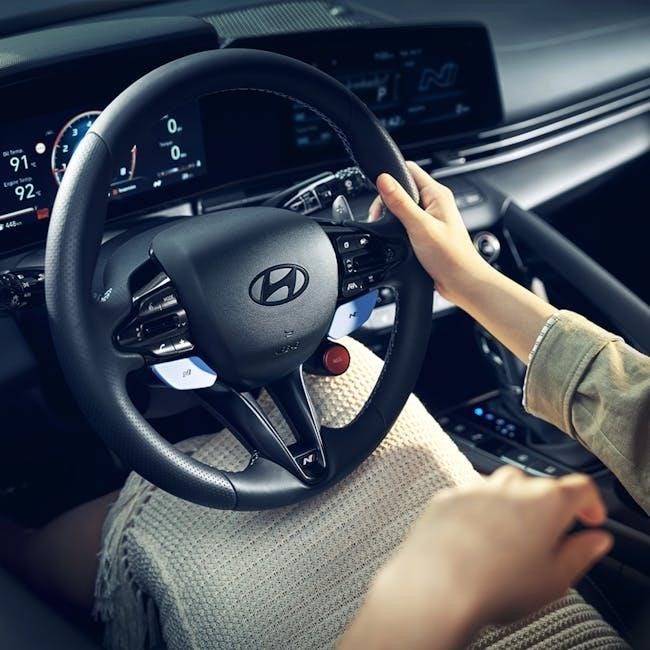
Manual and automatic cars have distinct features, with manual cars requiring driver input to change gears using a clutch and gearshift, and automatic cars shifting gears automatically using a torque converter and sensors always․
Overview of Transmission Types
Transmission types play a crucial role in the overall performance of a car․ There are several types of transmissions, including manual, automatic, and semi-automatic․ Manual transmissions require the driver to manually change gears using a clutch and gearshift, while automatic transmissions use a torque converter and sensors to automatically shift gears․ Semi-automatic transmissions, on the other hand, use a combination of manual and automatic components to provide a unique driving experience․ The choice of transmission type depends on various factors, including driving style, road conditions, and personal preference․ Each type of transmission has its own advantages and disadvantages, and understanding these differences is essential for car owners and enthusiasts․ By knowing the different types of transmissions, drivers can better appreciate the complexity and sophistication of modern cars and make informed decisions when purchasing or maintaining a vehicle․ Various transmission types are available in the market․

Types of Semi-Automatic Transmissions
Dual-clutch and automated manual transmissions are types of semi-automatic transmissions available․
Semi-Automatic Transmission Description
A semi-automatic transmission is a type of transmission that combines elements of manual and automatic transmissions․ It uses a clutch and gearset similar to a manual transmission, but the clutch is operated automatically by the transmission․ This allows the driver to focus on steering and accelerating, while the transmission handles the gear shifting․ The semi-automatic transmission uses a variety of sensors and actuators to control the clutch and gear shifting, providing a smooth and efficient driving experience․ The transmission is designed to provide the benefits of a manual transmission, such as improved fuel efficiency and performance, while also offering the convenience of an automatic transmission․ Overall, the semi-automatic transmission is a versatile and reliable option for drivers who want a balance of control and convenience․ The use of electronic controls and sensors allows for precise and efficient gear shifting, making it a popular choice for many drivers․

Driving a Semi-Automatic Car
Driving a semi-automatic car requires using paddles or a gear lever to shift gears manually or automatically always with ease and control;
Shifting Gears in a Semi-Automatic Car
Shifting gears in a semi-automatic car is a unique experience, offering the driver a balance between manual and automatic control․ The process involves using paddles or a gear lever to manually shift gears, allowing for more driver input and control over the vehicle’s performance․ The semi-automatic transmission uses sensors and electronic controls to automate the clutch operation, making it easier to shift gears smoothly and efficiently․ The driver can choose to shift gears manually or let the car shift automatically, depending on the driving conditions and personal preference․ The semi-automatic transmission also provides a more engaging driving experience, allowing the driver to feel more connected to the vehicle and the road․ Overall, shifting gears in a semi-automatic car requires a combination of driver input and electronic control, making it a distinct and enjoyable driving experience․ The technology behind semi-automatic transmissions continues to evolve, offering improved performance and efficiency․

Common Issues with Semi-Automatic Cars
Electronic malfunctions and delayed gear changes are common issues with semi-automatic cars always requiring maintenance․
Maintenance and Repair of Semi-Automatic Cars
Maintenance is crucial for semi-automatic cars to prevent issues such as delayed or jerky gear changes․ Regular checks on the transmission system, sensors, and software can help identify potential problems early on․ Repairing semi-automatic cars can be complex and costly, requiring specialized tools and expertise․ It is essential to consult a professional mechanic who has experience with semi-automatic transmissions to ensure proper diagnosis and repair․ Additionally, following the manufacturer’s recommended maintenance schedule can help prevent common issues and extend the lifespan of the transmission․ By staying on top of maintenance and repairs, drivers can enjoy a smoother and more reliable driving experience in their semi-automatic cars․ Proper maintenance and repair can also help to improve fuel efficiency and overall performance, making it a worthwhile investment for semi-automatic car owners․ Regular maintenance is key to avoiding costly repairs․

History and Evolution of Semi-Automatic Transmissions
The history of semi-automatic transmissions dates back to the 1930s, with early systems being introduced in various forms․ Over the years, these transmissions have undergone significant evolution, with advancements in technology and design leading to improved performance and efficiency․ The development of semi-automatic transmissions was influenced by the need for a balance between manual and automatic transmissions, offering drivers more control and convenience․ As technology continued to advance, semi-automatic transmissions became more sophisticated, with the introduction of electronic controls and advanced materials․ Today, semi-automatic transmissions are a popular choice for many drivers, offering a unique blend of performance, efficiency, and convenience․ The evolution of semi-automatic transmissions has been shaped by the contributions of various manufacturers and engineers, who have worked to improve and refine these systems over time․ This has resulted in a wide range of semi-automatic transmissions being available, each with its own unique characteristics and advantages․